Eric Peterson (JHU, Ph.D. 2022)

Jessie Dibble (JHU, Ph.D. 2021)
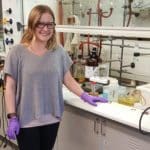
Robert Palkovitz (JHU, M.A. 2021)
Sayak Panda (JHU, Ph.D. 2021)
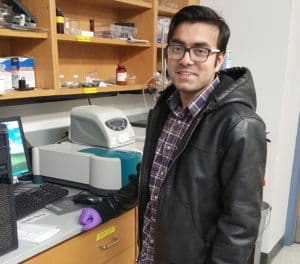
Sayak’s research demonstrated the systematic tuning of optoelectronic and electrical properties of peptide-pi conjugated materials based on molecular design principles. Following the completion of his Ph.D., he will join EY-Parthenon as a Consultant.
Garvin Peters (JHU, Ph.D. 2019)

Garvin’s research focused on the design and synthesis of novel photoresponsive molecules, illustrating how the photophysical properties of these small molecules and polymeric materials could be used for conductive materials. He also investigated linear and radial conjugation in extended π-electron systems combining linear intramolecular conjugation with the emerging properties of radial conjugation found in cycloparaphenylenes (CPPs). Following the completion of his Ph.D., he started working at Church & Dwight Co. as a research chemist.
Justin DeFrancisco (JHU, Ph.D. 2018)

Justin’s research focused on the design, synthesis, and characterization of novel π-conjugated organic compounds with unique electronic behavior. His work spanned two major projects: working towards photochromic polymers, and work on organic diradicals. He studied how aromatic cores could influence photochromic properties of dithienylethene monomers, and how sterics can affect the diradical character of quinoidal oligomers. Justin now works as a Scientist I at Solid Biosciences.
Reid Messersmith (JHU, Ph.D. 2018)
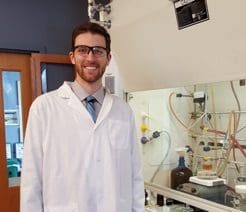
Reid’s research centered on the synthesis and characterization of novel borepin containing polycyclic aromatic compounds. Following completion of his Ph.D., Reid accepted an NRC post-doctoral research fellowship at the National Institute of Standards and Technology. Reid is currently a senior scientist at the Johns Hopkins Applied Physics Laboratory.
Herdeline Ann Ardoña (JHU, Ph.D. 2017)
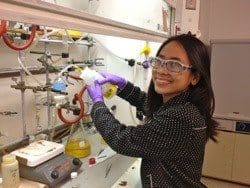
Herdeline‘s research addressed the understanding of molecular design and self-assembly principles of peptide-based optoelectronic assemblies, towards the development of functional multicomponent nanomaterials. She also explored the potential application of these materials and related conjugated polymers as a biological scaffold for neurons and cardiomyocytes. Following the completion of her Ph.D. work, she accepted a postdoctoral position in the research group of Professor Kevin Kit Parker at Harvard University. In 2020, Herdeline began working as an assistant professor at UC Irvine.
David Levine (JHU, Ph.D. 2016)
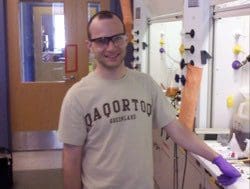
Dave’s research investigated the synthesis and characterization of novel fused aromatic heterocycles which incorporate a borepin ring into the framework, as well as a range of derivatives of these systems. Following completion of his Ph.D. work, Dave accepted a post-doctoral research position in the research group of Kenichiro Itami, at Nagoya University.
Allix Sanders (JHU, Ph.D. 2015)
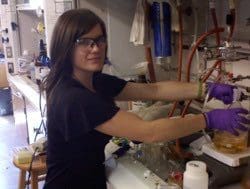
Allix’s research focused on the development of new synthetic routes for self-assembling pi-conjugated peptides, incorporating larger pi-systems in peptide backbones, and creating multivalent architectures through solid phase Pd-catalyzed cross-coupling. She also developed donor-acceptor peptide-pi hybrids capable of photoinduced electron transfer in water. Following the completion of her Ph.D. work, she accepted a post-doctoral research position at the NIH National Cancer Institute Center for Cancer Research. Allix is now working as a senior research scientist at Kite Pharma.
Benjamin Streifel (JHU, Ph.D. 2014)
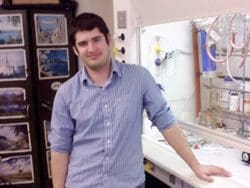
Ben’s research focused on the synthesis and characterization of novel small-molecule and polymeric π-electron systems based on the methano[10]annulene subunit, in particular demonstrating its potential for the development of amorphous organic electronic materials. Following the completion of his Ph.D. work, he accepted a post-doctoral research position at the US Naval Research Laboratory in Washington, DC. Benjamin is currently working as a senior scientist at Exponent.
Brian Wall (JHU, Ph.D. 2013)

Brian’s research involved the synthesis of self-assembling peptides containing π-conjugated subunits and studying the influence of amino acid sequence, macroscopic alignment, and molecular symmetry on the photophysical properties of the resulting higher order aggregate species. After completing his degree, he accepted a post-doctoral position in the research group of Professor Jeffrey S. Moore at the University of Illinois-Urbana Champaign. Brian is now working as a research and development manager at BD.
Alicia Fraind (JHU, Ph.D. 2012)

Alicia’s research focused on the synthesis of a variety of π-conjugated oligomers and related polymers in order to investigate the extent of electron delocalization within their neutral and oxidized forms. After completing her degree, she accepted a post-doctoral position in the research group of David S. Cafiso at the University of Virginia. Alicia is currently working as a registered patent agent at Morgan, Lewis & Bockius LLP.
Chris Harvey (JHU, Ph.D. 2011)

Chris’s research involved research toward the synthesis of segmented polymers bearing well-defined π-conjugated units for potential use as mechanochromic materials with reversible optical responses.
Stephen Diegelmann (JHU, Ph.D. 2011)
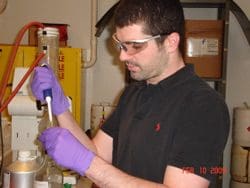
Stephen initiated the research involving synthesis and studies of self-assembling π-conjugated peptide materials. His work focused on the modification of polythiophenes for incorporation into peptides, on-resin dimerization chemistries, tailoring amino acid sequences to peptide drive assembly, and the polymerization of imbedded diacetylene units within assembled nano-fibers. After graduating in 2011, Stephen held a Postdoc position in Prof. Stuart Rowan’s lab in the Macromolecular Science & Engineering Department at Case Western Reserve University where he worked on the development of stimuli-responsive smart polymer nano-composites. Following his Postdoc, Stephen began working at Afton Chemical Company in 2013 in his hometown of Richmond Virginia, where he was a Senior R&D Chemist in the New Components group of Afton’s Engine Oils division. Now, Stephen is the chief operating officer at Horizon Incorporated.
Anthony Caruso Jr. (JHU, Ph.D. 2011)

Upon joining Tovar group, Anthony began a project based on incorporating weakly aromatic boron-containing subunits into larger molecules and eventually polymers. The neutral frameworks of borepins, which are seven-membered 6π-electron heterocycles that are formally aromatic, had not been previously explored. Anthony synthesized the first completely air- and moisture-stable class of functionalizable dibenzoborepins and more extended systems from retrosynthetic analysis to the final characterization of their structural and electronic properties by X-ray crystallographic analysis, UV-vis, photoluminescence and cyclic voltammetry. As a result, these studies revealed that borepin-containing subunits are promising π-conjugated building blocks for larger organic electronic materials. Anthony is now the president of Carbro Constructors Corp.
Patricia Peart (JHU, Ph.D. 2010)
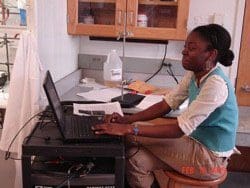
Patricia’s doctoral research demonstrated the potential for methano[10]annulene as a functional and useful component in the design of new organic electronic materials. She examined the qualitative extent to which the annulene promoted extended delocalization within conjugated polymers using several electroanalytical techniques. She prepared a variety of unusual electronic materials derived from thiophene and furan-based polymers, and initiated a continuing project in the synthesis of highly soluble annulene polymers prepared by chemical synthesis for use in electronic applications. In addition to the studies of 10 π-electron aromatics, she also considered another classic aromatic structure in the context of conjugated polymers, that of the influence of cyclopropenones (as surrogates for 2 π-electron cyclopropenium cations).
Ashley Zacca (JHU, M.A. 2013)
Ashley’s research involved the synthesis of self-assembling π-conjugated peptides and the study of amino acid sequence variation on the properties of the resulting higher order aggregates. In particular, UV-Vis and photoluminescence spectroscopy were used to show that intrachain distance between peptide-based steric bulk and the π-conjugated chromophore influenced interchain electronic coupling between the π-conjugated subunits.
Daryl Guthrie (JHU, M.A. 2008)
Daryl’s research involved the synthesis of sterically crowded polyaromatic systems as potential precursors for photochromic switching materials. I the course of his research, he uncovered a selective aromatic halogenation reaction that involved a “conformational protecting group.” The key substrates had several mutually reactive sites where one could envision electrophilic substitution chemistry, but the conformation of the molecular architecture in essence enhanced the reactivity of specific sites. This selectivity enabled the rapid synthesis of highly complex molecular electronic materials without the need for laborious subunit synthesis or wasteful protection schemes.
Jasmyn Abrams (Virginia Commonwealth University, REU summer 2016)
Jasmyn’s summer research focused on solid phase synthesis of oligosilane-conjugated peptides on an amide-linked resin and exploring photophysical and morphological properties of the resulting nanomaterials. We have also applied the technique to synthesize longer oligothiophene-peptide units.
Alyssa Ertel (University of Idaho, REU summer 2015)
Alyssa’s summer research focused on the investigation of structural and photophysical effects of temperature variation on self-assembling pi-conjugated peptides. This involved the synthesis of a couple of quaterthiophene, oligo(p-phenylenevinylene), and polydiacetylene-containing peptides, as well as studying their temperature-dependent self-assembly and photophysical properties using electron microscopy and spectroscopic techniques.
Matteo Togninalli (École polytechnique fédérale de Laussane, BSc, 2014)
Matteo’s undergraduate research involved the investigation of the structure-property relationships of self-assembling optoelectronic peptide hydrogelators. He studied the dependence of nanostructure morphology, aggregate photophysics and mechanical properties of the gels on the amino acid sequence of the peptide moiety using electron microscopy, steady state spectroscopy, rheological measurements and AFM nanoindentation.
Jordan Villa (College of William and Mary, REU summer 2013)
Jordan’s summer research involved the synthesis and photophysical characterization of self-assembling π-conjugated peptide heterostructures bearing biologically active peptide sequences. A number of these compounds were used for in vitro studies with Schwann cells.
Mary Bedard (Elon university, REU summer 2010/2011)
Mary’s summer research involved several aspects of peptide nanomaterial synthesis, from the incorporation of new chromophores into the peptide backbones to the evaluation of bioactive peptide sequences attached to the π-electron units. Some of the materials she worked with were used directly for in vitro cell culture studies.
Giselle Elbaz (JHU, B.A. 2010)
Giselle’s undergraduate research involved several aspects of the methano[10]annulene project. She evaluated EDOT-annulene copolymers to observe the influence of comonomer feed ratio on the electronic properties of resulting polymers, using cyclic voltammetry, in situ conductivity and spectroelectrochemistry. She also studied model non-polymerizable annulene monomers in order to understand the charge and spin distribution of radical cations. These studies involved chemical oxidation of the models followed by UV-vis and EPR investigation, or direct spectroelectrochemical measurements.
Geeta Vadehra (JHU, B.A. 2009)
Geeta’s undergraduate research was focused on the incorporation of naphthalene and perylene diimide units into the backbones of self-assembling peptides. She initially was preparing non-symmetric “amino acids” for standard peptide synthesis, but she later discovered that dianhydride molecules when exposed to the peptide synthesis resin underwent double imidation on the resin. This finding is general for a variety of π-conjugated biselectrophiles and has led to the broad development of exciting peptide materials with embedded π-electron units.
Stephanie Naufel (Arizona State University, REU summer 2009)
Stephanie’s summer research involved initial explorations of bioactive peptide signal incorporation into self-assembling electronic peptide architectures. This involved synthesis of key chromophores and peptides as well as investigation with AFM. She demonstrated that the bioactive sequences still allow for nanostructure formation.
Lindsay Repka (Barnard College, Summer 2007)
Lindsay’s summer research involved the study of thiophene-annulene copolymers to understand how annulenes impacted conducting polymer properties such as oxidation potential and electrochromic response. She also prepared soluble annulene monomers for chemical polymerization studies.
